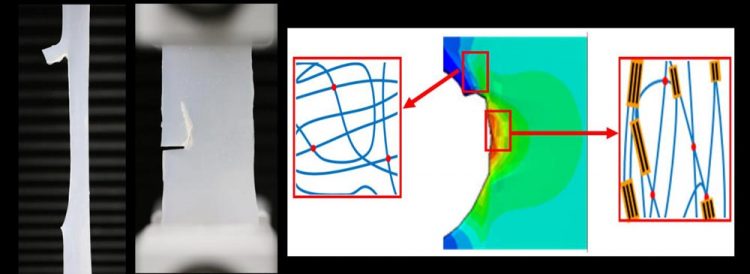Texas A&M researcher makes breakthrough discovery in stretchable electronics materials

Sideways cracking in a silicone elastomer. Credit: Dr. Matt Pharr/ Texas A&M University Engineering
With a wide range of healthcare, energy and military applications, stretchable electronics are revered for their ability to be compressed, twisted and conformed to uneven surfaces without losing functionality.
By using the elasticity of polymers such as silicone, these emerging technologies are made to move in ways that mimic skin.
This sheds light on why Smooth-On Ecoflex, a substance most commercially used to create molds and movie masks and prosthetics, is the most prominent silicone elastomer (a rubber-like substance) found in research.
While handling a sample of the material, Dr. Matt Pharr, assistant professor in the J. Mike Walker '66 Department of Mechanical Engineering at Texas A&M University, and graduate student Seunghyun Lee, recently discovered a new type of fracture.
“I have done some work in the area of stretchable electronics, so I have a lot of materials from when I was a postdoc. We had to store samples in our office and, likewise, I had some here because we were going to use them in a project that we ended up not doing. I'm a nervous fidgeter and while I was playing with it, I noticed something weird,” said Pharr.
This oddity is what Pharr and Lee refer to in their recent publication “Sideways and Stable Crack Propagation in a Silicone Elastomer” as sideways cracking. This phenomenon is when a fracture branches from a crack tip and extends perpendicular to the original tear.
Their findings not only provide a fresh, new perspective on the formation of factures and how to increase stretchability in elastomers, but also lay the foundation for more tear- and fracture-resistant materials.
“Initially this material is isotopic, meaning it has the same properties in all directions. But once you start to stretch it, you cause some microstructural changes in the material that makes it anisotropic — different properties in all different directions,” said Pharr. “Usually, when people think about fracture of a given material, they're not thinking about fracture resistance being different based on direction.”
This conceptualization, however, is critical to innovation and advancement in stretchable electronics.
As Pharr explained, upon loading, polymers with incisions tend to be ripped apart from one end to another. However, materials that exhibit sideways cracking stop the fracture from deepening. Instead, the incision simply expands alongside the rest of the elastomer and eventually, once stretched enough, looks like nothing more than a small dent in the surface of the material — negating further threat from the original crack.
This allows the unharmed section of an elastomer to retain its load-bearing and functional properties, all while increasing stretchability.
Going forward, by investigating how to reverse engineer microstructures that lead to sideways cracking, researchers can harness the benefits associated with it and develop application methods to materials that do not normally exhibit such fractures. This would lead to better fracture resistance in the very thin layers of elastomers used in stretchable electronics, as well as greater stretchability — both of which are key to the advancement and future usability of such technologies.
“To me, this is scientifically intriguing,” said Pharr. “It's not expected. And seeing something that I don't expect always sparks curiosity. (The material) is literally sitting in a drawer in my desk and this was all inspired by playing around.”
Media Contact
More Information:
https://today.tamu.edu/2019/05/29/lights-camera-fracture/All latest news from the category: Materials Sciences
Materials management deals with the research, development, manufacturing and processing of raw and industrial materials. Key aspects here are biological and medical issues, which play an increasingly important role in this field.
innovations-report offers in-depth articles related to the development and application of materials and the structure and properties of new materials.
Newest articles

Hyperspectral imaging lidar system achieves remote plastic identification
New technology could remotely identify various types of plastics, offering a valuable tool for future monitoring and analysis of oceanic plastic pollution. Researchers have developed a new hyperspectral Raman imaging…

SwRI awarded $26 million to develop NOAA magnetometers
SW-MAG data will help NOAA predict, mitigate the effects of space weather. NASA and the National Oceanic and Atmospheric Administration (NOAA) recently awarded Southwest Research Institute a $26 million contract…

Protein that helps cancer cells dodge CAR T cell therapy
Discovery could lead to new treatments for blood cancer patients currently facing limited options. Scientists at City of Hope®, one of the largest and most advanced cancer research and treatment…



